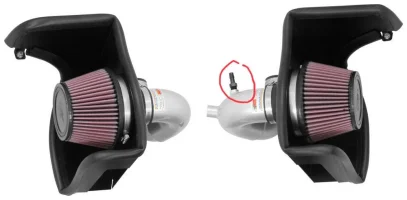UPDATE - PICS GALORE ADDED! See notes above each pic for information if/when applicable.
Insulation Wrap (Bottom)

Insulation Wrap (Complete)

Metallic Fleck Intake Tubing Paint

Intakes Installed

Extended Weatherstripping - You'll notice some "indentation" on the weather stripping. This is where it meets the hood's bulge, so this DOES partially seal with the hood after all!

Filling Heatshield Gaps - I placed as much weather stripping around the area to fill in gaps where hot air definitely would flow in.

Pic of Insulation Installed - These DO make a MASSIVE different in temperatures. When the car is sitting a long time and everything heat soaks, that can't be helped. However, even in 90+ degree weather driving 50+ miles,
I can open my hood and touch the inside of the heatshield and it is ambient temperature while the other side where the insulation is has massive heat waves hitting it and the insulation itself is warmer (but obviously not hot or it wouldn't be doing it's job).

Big Gaps On Bottom - These gaps CAN be filled with stuff if one so-desires, but the weird shape means coming up with something weird and jenky (jenkier?) looking...

Backside Insulation

Strut Tower Brace Weatherstrip - This looks by far the stupidest, but it does help close the gap...

Strut Tower Brace Weatherstrip - So I took my stupidest idea and did it on the other side, too...

REVIEW:
After nearly 300 miles on the K&N Typhoon intake system, I have generally positive things to say. First, after my modifications to it, I essentially have all of the benefits of the intake with nearly none of the heat soak problems. The car remains responsive in even the hottest weather unless it sits in a parking lot for 30 minutes in which everything heat soaks anyway because there is no air flow and the heat will seep into everything.
In terms of power, it's hard to determine the gains from the good ol' butt dyno. It seems that if one wishes to get more power out of the Stinger GT, it is smarter to look first at the exhaust system and the tuning. This bodes well for the stock intake design, and I reckon many of you can simply get away with never installing an intake and barely notice the difference in power. This may partially be attributed to the filters being rather small: their surface area doesn't seem to add a whole lot. But then again you'd miss the best part...
This intake simply sounds like nothing I would have ever expected. There's no denying that you will scare Burger-King-parking-lot-burnout-donut-speed-racer Joe. He won't race you, because you toss some 4k revs and he's foolish enough to think that whooshing sound is the sound of 600HP. You will love the WOT sound because you think that there weren't any tiny animals on the road in front of you, but they're actually all trapped in your intake. You'll be scared to go half throttle, because that's when the cops look at you and think about all the possible fix-it tickets they could be writing you to make their day interesting. You will love the sound of this intake, period.
The installation itself is relatively straightforward. As mentioned above, keep an eye on that fitting because it affects your ISG (and your gas mileage), and also in a post, the driver's side intake box DOES touch some AC lines. If you insulate your box, you'll have less worry as the AC lines are ALSO insulated, so two padded things rubbing each other shouldn't cause any immediate concern. I will, of course, keep an eye on it regularly. Otherwise, everything is as expected from the instruction guide.
My final take on this is that you will need an intake eventually when/if you are seeking absolutely all the power you can get. If you pick this intake, you won't be disappointed by the sound at all whatsoever, it looks different if you're into being unique, but you may not really notice gains until other
mods are making better use of it. If you're looking at your first mod, this one shouldn't be it: go for your exhaust first.





















